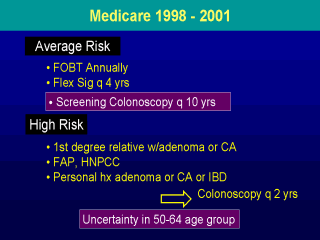 |
In 1998, Medicare said for the
first time that they were going to cover screening for colorectal cancer and would pay for
FOBT annually and for flex sig every four years. They defined some higher risk groups for
which they’d do colonoscopy every two years. Incidentally, they really went ahead of the
curve, because some of the groups they’ve identified as high-risk, such as those with a
family history of adenoma, are still being debated. Regardless, they set the benchmark.
Then, there were very few screenings done. The public wasn’t catalyzed to go get
screening. Additionally, if you went for a screening flex sig under Medicare and found a
polyp, which you have a 25% chance to find, then that procedure was coded not as a
screening flex sig, but as a diagnostic flex sig. That meant there was no way for Medicare
to track how many procedures were really screening and how many were diagnostic. With the
new data coming through about colonoscopy and older people having a higher risk of
proximal cancer, Medicare announced they would cover colonoscopy once every ten years.
This was as of July 1, 2001. That means that everyone who’s over 65 on Medicare is now
eligible to have a standard colonoscopy. I think there’s no going back from that. I
don’t mean to criticize it; I think it’s a great achievement. But what really still
comes to play is what to do in the 50-64 year old age group. Insurers are not jumping on
the bandwagon to pay for colonoscopy in this group. Remember the risk is a little lower as
you’re younger, you don’t have maybe the same proximal risk, and if you start taking
all 50 to 64 year olds you’re going to spend a lot and the costs are extremely high. |
